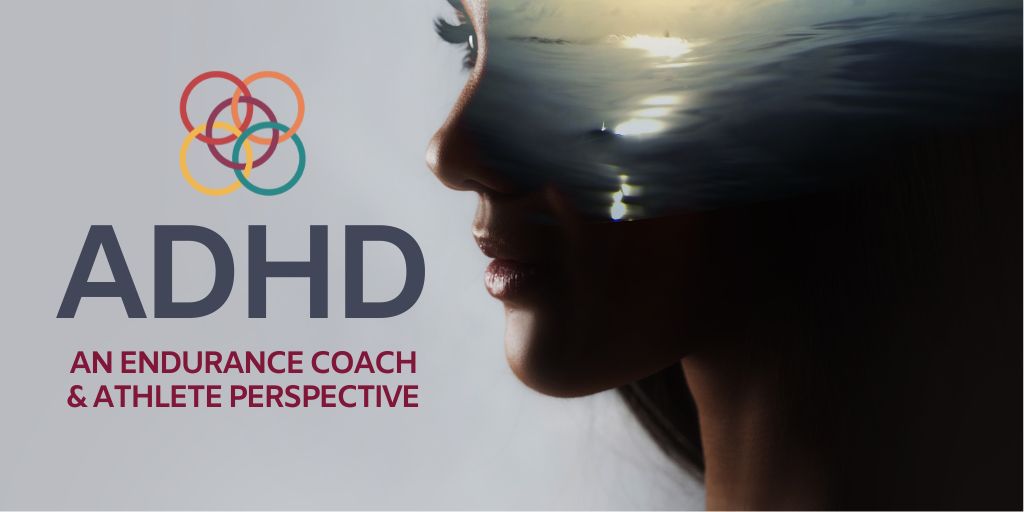
Dirty 30 Race Report
April 17, 2024
The Ultimate Triathlon Race Day Packing List
May 28, 2024ADHD and the Adult Endurance Athlete
What do Olympic athletes Michael Phelps, Simone Biles and Molly Sidel have in common besides Team USA bling? They have ADHD. Research suggests that ADHD may be more prevalent in athletes, with up to 8% of athletes having the condition, compared to 2-3% of the general adult population. Exercise can temporarily relieve symptoms of ADHD, which could explain the higher prevalence – perhaps we are unknowingly drawn to sport to help us feel better.
Doesn’t ADHD only affect 4th grade boys?
The stereotype that ADHD is condition of young white males is an example of stigma. Education is the best way to fight stigma, so this post is my attempt to share some knowledge and my experience with ADHD. So, here are some facts about ADHD.
What ADHD Is (and Isn’t)
Like many mental health conditions, Attention Deficit Hyperactivity Disorder (ADHD) is misunderstood. It’s not laziness or defiance. It’s a neurodevelopmental disorder that begins in childhood and is marked by persistent patterns of inattention, impulsivity, restlessness and hyperactivity.
The brains of individuals with ADHD process information and emotions in a different way. A recent study of over 10,000 ADHD brains confirmed heightened connectivity between the processing center that regulates learning, movement, reward, and emotion and the frontal cortex that controls attention and self-control.
Subtypes and Causes
ADHD is divided into 3 subtypes; Hyperactive, Inattentive or Combined. Inattentive Type was formerly known as ADD.
A definitive cause of ADHD is unknown, but genetics is a big contributor. Neuro-development issues like low birthweight or maternal stress, trauma or smoking can contribute to symptoms, as can environmental exposures like pollutants or pesticides.
ADHD symptoms can resolve with age. A meta-analysis found that by 25 years old, 15% of people retained their full ADHD diagnosis, and 65% were in partial remission of symptoms, and 20% no longer experienced symptoms.
ADHD diagnosis is 3x more common in males – but this number may be skewed. Hyperactivity and impulsivity are common symptoms in boys, which causes disruptive behavior very noticeable to parents or educators. Girls have more attention issues, but also tend to learn coping skills at a younger age, so they may be less likely to get diagnosed.
We can all relate to the hallmark ADHD symptoms from time to time, but for someone with ADHD they are pervasive, challenging and significantly impact quality of life. Adults with ADHD may have:
Common Adult Symptoms
We can all relate to the hallmark ADHD symptoms from time to time, but for someone with ADHD they are pervasive, challenging and significantly impact quality of life. Adults with ADHD may have:
- difficulty organizing and planning
- trouble paying attention
- difficulty staying on task
- restlessness
- impulsiveness or erratic behavior
- indecisiveness
- emotional control challenges
- difficulty following written or verbal instructions
- time blindness or time anxiety (feeling anxious when having to wait; impatience)
- task paralysis; reluctance to get started on tasks
Hyperactivity tends to decline over time, but other symptoms can become more prevalent with age and stress. Many people are diagnosed as adults – like me!
Over 60% of adults with ADHD have other psychiatric conditions such as bipolar disorder, personality disorders, depression, anxiety or substance abuse disorder, which makes an ADHD diagnosis difficult.
Quirky or Quacky – my ADHD diagnosis at 46-years old
I thought I was just quirky, energetic and a little rebellious. I laughed off my inability to follow a recipe or a training session and I delighted in my creative problem solving and my fearless approach to any project. Looking back, I see signs of ADHD in my younger years, but I unknowingly developed coping skills and functioned well.
When the Wheels Came Off
I thought I was just quirky, energetic and a little rebellious. I laughed off my inability to follow a recipe or a training session and I delighted in my creative problem solving and my fearless approach to any project. Looking back, I see signs of ADHD in my younger years, but I unknowingly developed coping skills and functioned well.
As I approached my 40s things changed. My ability to prioritize important tasks for training, work, and family declined. I found myself in catch-up mode constantly, scrambling to meet deadlines. I stayed busy but would get sucked into the wrong tasks for hours, diving deep into my latest creative idea, only to leave it unfinished as started the next thing. Sometimes I would “work” all day but have nothing to show for it.
I would be incredibly productive from 6am to 9am (my coffee {stimulant} hours) but by 10, I couldn’t stay in my chair for more than 5 minutes, and I would evenutally crash. Napping was my daily refuge- sometimes my couch naps were hours long. My emotions became volatile too. Making dinner brought me to tears because I couldn’t focus on such an overwhelming task. I tried hard to take good care of myself, but it wasn’t my body that was tired, it was my brain!
A Late Diagnosis, Big Relief
Life was getting complicated, so I eventually sought out help. My therapist mentioned ADHD in one of our first sessions. I reached out to my PCP of 18 years who said that he had “always suspected” that I had ADHD (still a bit miffed about that one). I was referred to a Psychologist for testing and many tests and a few months later was diagnosed with ADHD – inattentive type.
To learn that I had ADHD at 46 years old was unexpected, but also an incredible blessing. Having insight in to how my brain works, along with medication and therapy has been life-changing.
ADHD and the Endurance Athlete
Adult ADHD is very complex, with symptoms that come and go and affect everyone differently. I am not qualified to offer medical advice or diagnosis, but my experience as an athlete and coach gives me insight into training with ADHD.
Long-distance event prep typically favors the Type A, organized type. Athletes with ADHD may face additional challenges and need to adapt their approach to training.
Here’s the good news – ADHD does not limit performance. In fact, there are days when unbounded energy can be a superpower, hyperfocus allows you to block out distractions in a competition and getting lost in your thoughts is a lifesaver on a long ride or run!
ADHD Symptoms + Endurance Training Hacks
ADHD Symptom #1: Impulsivity
Impulsive decision making can lead athletes to regularly go off-plan, throw in unexpected hard efforts during easy sessions, enter races at the last minute, skip recovery or completely different training than what your coach or plan prescribed. These last-minute intensity changes can greatly affect the athlete’s performance and recovery. Many athletes struggle with the idea that they will be better if they do more training, but this is particularly prevalent with ADHD athletes, who tend to be restless and have excess energy.
A strong understanding and “buy in” of your training plan and goals can help the ADHD athlete reduce impulsive decisions. When an impulsive decision is made, it should be approached with flexibility. Training can be adjusted to accommodate for an unexpected change in training load – just please don’t do it during taper!
ADHD Symptom #2: Difficulty Planning
For endurance athletes, daily, weekly, and seasonal planning is critical, and extra care is needed to balance family, work, and life obligations. It can be very overwhelming. Planning is never top of mind for the ADHD brain. We tend to jump into the middle of projects and work in all directions, a risky approach that can lead to being under-prepared or becoming injured from overreaching. Plus poor planning adds stress and the subsequent feelings of overwhelm can be magnified for an ADHD athlete.
Planning for an ADHD athlete needs to be simple, fun and flexible. Think about what works for you? Do you like paper or digital plans? I have a blast making complicated, colorful spreadsheets – the creative aspect helps me stay on task.
It’s also helpful to start planning at the end of your season and work backwards – an approach that works particularly well for my brain and may for yours too!
Try to keep your planning process intuitive for your brain, and that may mean only planning small chunks at a time. You could first make a list of your performance objectives – the big things that need to happen in training. Put them in a logical order, and tackle each item on the list individually.
Finally, don’t be afraid to ask for help. Planning is a big reason why many athletes choose to hire a coach.
ADHD Symptom #3: Poor Time Management
Difficulty with time management, time perception, time distortion, and future memory are all symptoms of ADHD, unique to each individual. These and other time-related neurological aspects of ADHD can lead to unintentionally missed training sessions.
Time perception is the ability to “feel” time and arrange your life to an inner “cognitive clock.” ADHD brains may perceive time moving faster, and underestimate the time needed for tasks, or not realize how much time they spent on a task, which can send your schedule into disarray.
Forgetting that you had a training session or that you need to pick up your kids may not always be an issue of poor working memory. The ADHD brain can have difficulty looking to the future – a time management issue with prospective memory.
My Personal Time Struggles
My ADHD struggles are mainly with time management – prospective memory, task paralysis and hyperfocus – I have a hard time getting started on things and switching tasks. I find myself avoiding the start of a task that may have too many steps – like a complicated training session. I also can fall behind or miss things because I am so focused on the plan I’m developing, or the {super long} blog post about ADHD, that it feels impossible to pull myself away.
Breaking up your day into blocks of time can help with managing time. Appointments and meetings are not the only things that should go in your calendar. Block off time for creative outlets and a “brain break” and the reward can help you stay on task.
Also, schedule your training sessions in your calendar and set up an alarm or phone reminder. There are many time management apps, and these can be a lifesaver. Consider scheduling your training prior to focus time – you’ll find that your ability to stay on task is heightened after exercise.
Creating habits is one of the best ways to get things done. When something is a habit, you just do it. Habits like training at the same time every day, drinking a big glass of water before your first coffee or a meal, or foam rolling while you watch TV are all ways to support your training without having to plan.
Finally, training with a group or a friend may also provide the time management incentive and mental boost needed to get in your training sessions.
ADHD Symptom #4: Difficulty Staying Focus
ADHD brains are naturally low on dopamine and norepinephrine, which control attention levels. This could present itself with the ADHD athlete struggling to complete long sessions or stay on task with the session goals and instructions.
Flexibility can go a long way here too. It can be hard to determine from one day to the next when your focus (or hyperfocus) will kick in, but when it does – embrace it! Recognize when you’re in the zone and use that time to get your “boring” or long sessions out of the way – and then adjust the rest of the week accordingly.
It can also be helpful to have clear, specific goals for training sessions. Ask yourself “what do I need to do with this session?” Understanding what is expected can help maintain a productive mindset.
Finally, find some distractions. Listen to a podcast on your swim, set up a computer stand at your trainer, or phone a friend during your long run. Giving your brain a break from the task at hand can help you to stick with it!
ADHD Symptom #5: Managing Intense Emotions
Emotional instability is a challenging factor in many mental
health conditions and ADHD is no exception. ADHD athletes may struggle to
manage frustration over a tough session, feel overwhelmed by a packed schedule
or stressed by a setback in training. While every athlete feels these feels,
the ADHD athlete’s emotions may be expressed as extreme sadness, disappointment
or anger, or feelings of failure or even shame. It can be difficult to shift
from these emotions.
Tough training sessions are common, and endurance
performance gains are rarely linear. Managing expectations and emotions is a
very important aspect for athletes with ADHD who may struggle to “trust the
process” when they experience stress. Clearly
understanding and revisiting the long-term plan and creating micro-goals can
help athletes move past setbacks.
A training journal can be a useful tool to help you understand
how you respond to setbacks. When you recognize your triggers, it can help you
stay in control.
ADHD Medications
A combination of medication and theraputic interventions is a common protocol used to treat ADHD. ADHD medications may create additional challenges for ADHD athletes. There are both stimulant and non-stimulant medications, both of which come with side effects like loss of appetite, trouble sleeping, dry mouth and headaches – all of which can impact training. Some ADHD medications could be considered performance-enhancing, so athletes should investigate with a governing body to ensure that anti-doping violations do not occur.
ADHD Makes me a Better Coach
My ADHD symptoms present me with professional challenges every day. Even with treatment, I still get distracted, pulled off task, I am forgetful and get anxious. Treatment has helped my productivity and I can usually recognize when I am hyper-focusing or time-stalling. I use hacks like OneNote, digital timers, mini-rewards and video messages to keep me focused and productive. I also hired someone to help me with the business tasks that weren’t working well for me.
Before treatment, running a business was my main challenge – not the one-on-one coaching. My ADHD makes me unique, with a relentless creative energy. I often think outside the box and love the thrill of problem-solving. Bring me your problem, and I will help you solve it and I’ll talk your ear off in the process. As an ADHD hallmark, I love to hyperfocus on a training topic, season planning, or injury recovery protocol.
Living with ADHD has helped me to become resilient, to push past setbacks, to adapt my strategy, and to press on. I bring that to my athletes as well.
I also care deeply for my athletes and enjoy learning what makes them tick. My athletes become my family and I am invested in their wellbeing and success. I will walk with them through struggles and do anything in my power to build their confidence and help them succeed.
Owning Imperfection and Fit
Accepting my shortcomings and letting go of perfection is hard, but very helpful – it relieves my anxiety. So, I’m an open book with my athletes, and as another ADHD hallmark, I overshare about my life. I own my mistakes, like falling behind or forgetting to send information. It happens, but I admit it and keep trying to improve. You’ll often hear me say “make sure you remind me about this!” I also accept that I am not the right coach for every athlete, and there are never hard feelings if someone moves on. Being okay with who I am makes my professional life easier.
If you look up the common “superpower” characteristics of individuals with ADHD you’ll see listed:
- Creativity
- Empathy
- Perseverance
- Hyperfocus
- Intuition
- Problem-Solving
- Sense of Humor
- Multitasking
- Compassion
You don’t see numbers person or detail-oriented on that list! But, that is OK! These superpowers can be applied to so many different careers and scenarios in life. I’m very fortunate that I found my “thing” in being a coach and trainer.
Adult ADHD Stigma: What Does that Mean?
I wanted to share my story to help athletes with ADHD and to also help reduce the stigma around ADHD, particularly in females. Stigma stems from a lack of understanding about mental illness and is felt when someone has an unfair attitude or belief about a person with a condition. Public stigma can lead to self-stigma, which can make people deny their symptoms, not seek treatment, or feel shame and embarrassment.
Here are some common ADHD stigmas:
We all know what it’s like to be forgetful or struggle to focus, and this can lead people to disregard an adult ADHD diagnosis as “no big deal” or something everyone deals with.
Despite the evidence, some people don’t believe that ADHD is a medical condition, and that opinion can be exacerbated because symptoms come and go. These people may see ADHD as an excuse for being lazy, messy or irresponsible.
Comments such as, “You’re a hot mess”, “you’re so scatterbrained” or “you don’t have ADHD, you’re just too busy” or if someone without ADHD describes a mistake or forgetfulness as, “I’m being so ADHD” stigmatize the individual that has ADHD.
A big stigma surrounds the use of ADHD stimulant medications. I’ve experienced this judgment several times, and I feel embarrassed even though the medication helps me. Here’s a video to learn more about how medications for ADHD work.
May is Mental Health Month
This blog post has been floating around in my cluttered brain since I learned I had ADHD last fall. It feels nice to get it out just in time for Mental Health Awareness Month. This is a time to reflect on how neurodevelopmental conditions, mental illness and addiction can affect us all.
I believe we are moving in a positive direction and can continue to reduce stigma with education and awareness. If you have ADHD, consider sharing your story. You can also learn more about ADHD at the CHADD website.
Finally – let’s go!! Still I Run is hosting a mile-a-day run/walk/move streak from May 1 to May 31. According to their website, “During the challenge, you’re asked to walk or run (or bike, hike, rollerblade!) at least one mile every day for mental health during mental health awareness month. This is the perfect way to get out there for your own mental health, while also smashing the stigma, earning sweet swag, and connecting with other warriors around the country”. Register here.
REFERENCES
Pagani, L. et al. 2020, April 7. Childhood exercise as medicine: Extracurricular sport diminishes subsequent ADHD symptoms. Retrieved from https://www.sciencedirect.com/science/article/abs/pii/S0091743520302802
Nazeer, A., et al. 2014, June 17. ADHD and Adolescent Athletes. Retrieved from https://www.ncbi.nlm.nih.gov/pmc/articles/PMC4060024/
Lufi, D., Parish-Plass, J. 2009, December. Sport-Based Group Therapy Program for Boys with ADHD or with Other Behavioral Disorders. Retrieved from https://www.tandfonline.com/doi/full/10.1080/07317107.2011.596000
https://www.trainingpeaks.com/coach-blog/how-coach-athletes-with-adhd
Kenter RMF, Lundervold AJ, Nordgreen T. A self-guided Internet-delivered intervention for adults with ADHD: a protocol for a randomized controlled trial. Internet Interv 2021;26:100485.
Williams OC, Prasad S, McCrary A, Jordan E, Sachdeva V, Deva S, Kumar H, Mehta J, Neupane P, Gupta A. Adult attention deficit hyperactivity disorder: a comprehensive review. Ann Med Surg (Lond). 2023 Apr 12;85(5):1802-1810. doi: 10.1097/MS9.0000000000000631. PMID: 37228994; PMCID: PMC10205222.
Mueller AK, Fuermaier AB, Koerts J, Tucha L. Stigma in attention deficit hyperactivity disorder. Atten Defic Hyperact Disord. 2012 Sep;4(3):101-14. doi: 10.1007/s12402-012-0085-3. Epub 2012 Jul 8. PMID: 22773377; PMCID: PMC3430836.



